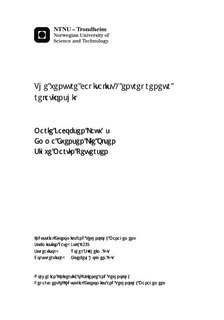| dc.contributor.advisor | Sørheim, Roger | nb_NO |
| dc.contributor.advisor | Holmen, Elsebeth | nb_NO |
| dc.contributor.author | Lauvås, Marie Jacobsen | nb_NO |
| dc.contributor.author | Pettersen, Sigve Martin | nb_NO |
| dc.contributor.author | Olsen, Emma Evensen Lie | nb_NO |
| dc.date.accessioned | 2014-12-19T14:29:51Z | |
| dc.date.available | 2014-12-19T14:29:51Z | |
| dc.date.created | 2014-07-02 | nb_NO |
| dc.date.issued | 2013 | nb_NO |
| dc.identifier | 731937 | nb_NO |
| dc.identifier | ntnudaim:10003 | nb_NO |
| dc.identifier.uri | http://hdl.handle.net/11250/266679 | |
| dc.description.abstract | In this master thesis we have performed an explorative study on the VC-entrepreneur relationship.Paper 1 is a literature review of several frameworks describing the VC-entrepreneur relationship, how these frameworks take the VC and/or the entrepreneur's perspective, and their applicability and limitations to the pre- and post-investment stage. Our main findings in this literature review show that little emphasis has been placed on the pre-investment stage and how the VC-entrepreneur relationship is initiated and developed. In addition few scholars take a demand-side view on equity finance which leads to an unbalanced understanding of the forces affecting the market for venture capital. Two main findings from Paper 1 was that social embeddedness may help explain how external parties in the entrepreneur's network may mediate the relation to investors and there is a need to further investigate how the entrepreneur may initiate and build relationships towards investors in an early venture stage. Thus the following papers aim to explore these findings. Paper 2 investigates how outside directors may strengthen entrepreneurial ventures in an early stage by performing explorative case analyses. Our findings suggest that outside directors may strengthen high-growth entrepreneurial ventures in an early stage by increasing the ventures competitive advantage in terms of strategically combining and managing resources. In addition they add legitimacy towards external stakeholders and increases the ventures interaction with its surroundings. The implications from Paper 2 suggest that more qualitative research should be performed on how the outside directors' strengthening contribution to early stage ventures can be related to stage theory.Paper 3 explores how entrepreneurs may develop investment readiness to bridge the financing gap and become seed level investor ready. This was done by conducting an explorative, theory building case study. From exploring the investment readiness we build a model that are able to relate investment readiness to the stages of development, and offers an explanation to how entrepreneurs use social ties as an information transferring mechanism effectively developing the investment readiness of the venture in order to overcome the high level of information asymmetry and risk related to the early stages of venture development. The implications from paper 3 suggest that the use of social ties could improve the entrepreneurs ability to become seed stage investor ready and effectively bridge the gap in early stage venture capital. | nb_NO |
| dc.language | eng | nb_NO |
| dc.publisher | Institutt for industriell økonomi og teknologiledelse | nb_NO |
| dc.title | The venture capitalist - entrepreneur relationship | nb_NO |
| dc.type | Master thesis | nb_NO |
| dc.source.pagenumber | 140 | nb_NO |
| dc.contributor.department | Norges teknisk-naturvitenskapelige universitet, Fakultet for samfunnsvitenskap og teknologiledelse, Institutt for industriell økonomi og teknologiledelse | nb_NO |

